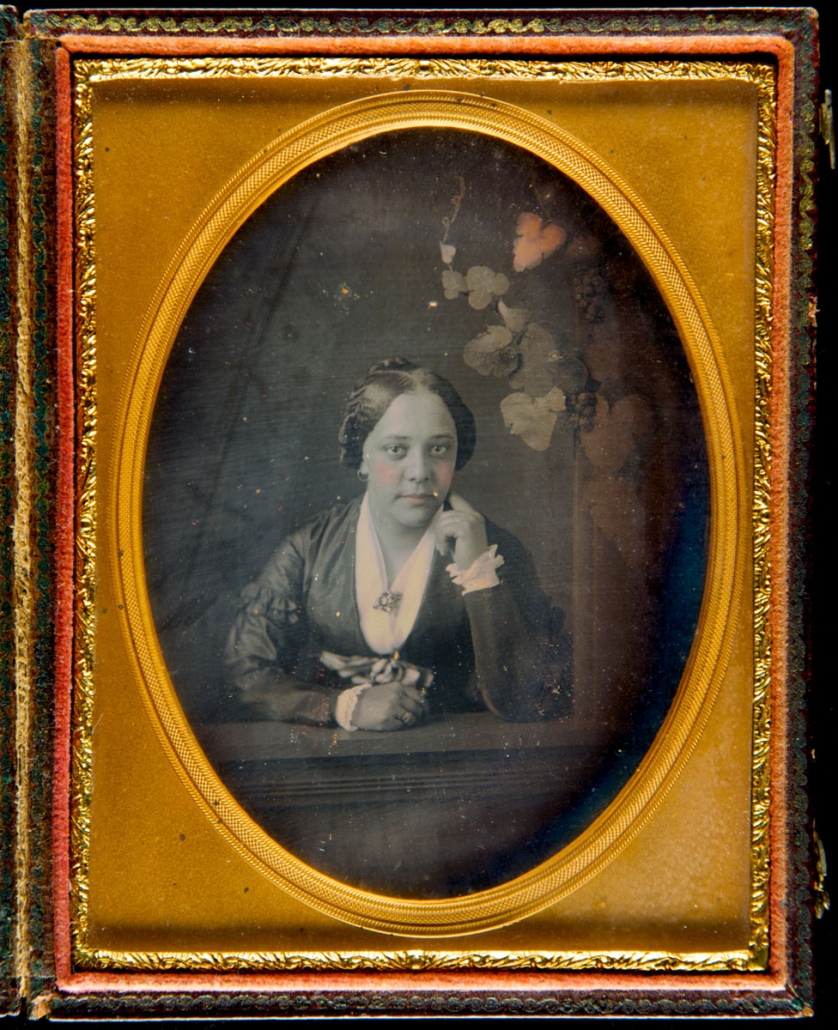[Portrait of an Unidentified African American Woman].
Tanya Sheehan, William R. Kenan Jr. Professor of Art, Colby College

Examined only digital image.
Broadbent, Samuel, 1810-1880, photographer.
[Portrait of an Unidentified African American woman].
Philadelphia, ca. 1850.
Daguerreotype.
Dickerson family.
Part of the Dickerson Family Collection and the Library’s African American History Graphics Collection.
Cased photos [P.9427.13]
Keywords: studio portrait photography; honorific portraiture; photographic lighting; photographs of African Americans; Frederick Douglass
Description:
The unidentified sitter in this studio portrait is believed to be a member of the Dickerson family, who lived on Locust Street in mid-19th-century Philadelphia. Widowed in 1838, the matriarch of the family managed the bar at the Walnut Street Theatre and raised a family of five; she later married a cabinetmaker and activist in Philadelphia’s growing African American community. The cased portrait was one of seventeen daguerreotypes and tintypes that belonged to the family and entered the Library Company’s collection, along with friendship albums compiled by two of the Dickerson daughters.
Without the sitter’s name, there is much about the portrait we cannot know, from its precise date to the personal circumstances that occasioned its making. Yet seeing the sitter as part of a middle-class African American family like the Dickersons tells us something about the significance and conditions of her photographic experience. As the abolitionist Frederick Douglass proclaimed in the 1860s, the daguerreotype put the act of self-representation into the hands of a great number of Americans. Photographic studios were plentiful in Philadelphia beginning in the 1840s, and the patronizing of such an establishment was considerably less expensive than commissioning a painter to render one’s likeness. For people of African descent, dignifying studio portraits were also powerful expressions of agency that combatted the racist stereotypes dominating popular visual culture. In the daguerreotype under discussion, we see a young woman with a stylish coiffure and dress, adorned by a lace collar and brooch, looking directly at the camera. She gently rests a forearm and elbow on a window frame surrounded by leafy vines. Derived from portrait painting, these distinctive props lent a sense of naturalness to a highly constructed scene; they also help identify the photographer as Samuel Broadbent, who established one of Philadelphia’s finest portrait studios on Chestnut Street in 1851. Broadbent set his sitter’s mouth in what early photographers called a “pleasing expression,” or one in which the lips remain closed and slightly curved upwards. That expression was essential to performances of gentility both within and outside the portrait studio, and so bearing one’s teeth was common only to photographic humor before the turn of the 20th century.
American photographers learned from their trade literature how to dress, pose, and surround their studio patrons so they performed an ideal self for the camera—an ideal defined exclusively in terms of whiteness in the mid-19th century. This meant that people of all races could be posed with the same props and backdrops, but photographers often treated the physical features they associated with nonwhite bodies as technical problems that required careful treatment. Broadbent therefore would have exposed the dark-complexioned members of the Dickerson family to considerable light so their features would be legible and look as “white” as possible in the resulting portraits. Then as now, the light sensitivity of photographic technology was designed to privilege subjects with fair skin tones. Douglass did not dwell on this technical deficiency and the racial hierarchy that motivated it in his celebration of daguerreotypy. For him—and for many historians of photography since—the accessibility of early photographic portraiture and its potential to counter demeaning stereotypes made it a potent social tool for African Americans.
